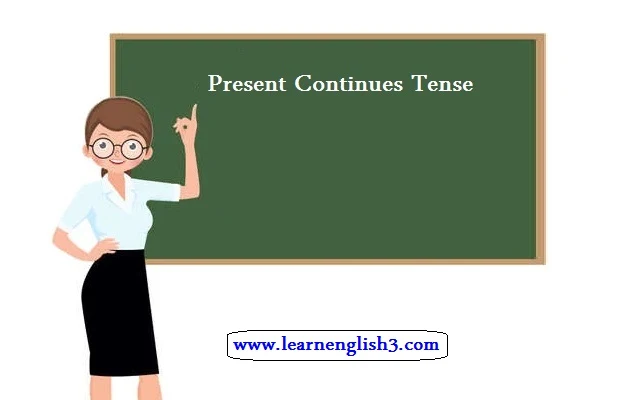Present Continues Tense
We use the present continuous tense to express an event that started a short time ago and is continuing to happen at the time we are talking about it (now).
Signal Words for Progressive Present
There are words when we find them in the sentence, we use the present continuous because these words indicate that the action continues at the time of speaking
now / at the moment / at present / today / look / listen / this week / month/ year
Sentence Formation
To put the verb in the present continuous tense: we put am -is -are before the verb to be converted, and add it at the end of the verb-ing
Am/is/are + + is the infinitive of the verb ing, and so the verb form is in the present tense.
Examples
- Sam is playing now. _ Listen, we are singing. _ Sara is drawing pictures today.
- Look,l am eating pasta. -- Sam is studying English this week
- They are playing football at the moment.
Note
(1)- Verbs whose infinitive ends in (a consonant and preceded by a vowel), before putting ing at the end of the verb we double (write it twice) the consonant at the end of the infinitive, for example, run-running / swim-swimming / hop-hopping / clap-clapping/cut-cutting (the vowels are a-e-i-o-u), the rest of the English letters are consonants.
(2) - Verbs whose infinitive ends with the letter e, when we add ing to its ending, we delete the letter e from the last, examples: bake-baking / make make-making / take-taking / ride-riding / write-writing / come - coming
Practice: // Correct the verb:
- Sam play football at the moment. (Sam…………………)
- Look, we clean the rooms . (we ……………………………..)
- Sara bake bread now. (Sara………………………………..)
- The boy swim in the sea now. (The boys………………..)
- Listen , He read in his room. ( He ……………………..)
To negate the sentence placed in the present continuous tense: we add the negative adverb not / n't after the verb am - is- are
Examples
- Sam is jumping - Sam is not / isn't jumping /
- l am studying – I'm not studying
- Sara is eating – Sara is not eating / We are walking – We aren't /are not walking
Practice: // Turn the positive verb into a negative one:
- We are working. (We …………………………………………..)
- She is washing. (She ………………………………………….)
- I am speaking. (I ………………………………………………)
- They are drawing. (They …………………………………………)
Continuous Tense
To form the question starting with Is: We use the following verbs at the beginning of the sentence meaning (Is) Am - Is - Are and the formation of the question is as follows
Am - Is -Are Is + + verb infinitive ( + subject ing ) ?
Examples:
Is Sam playing? -Yes, he is playing. No, he isn't playing
Are you swimming? / Yes, l am swimming - No, l am not swimming:
Practice: Complete the question:
- ....…..cooking? - Yes, l am cooking.
- …………………… writing? No, they aren't writing.
- ……………….… baking? Yes, Sara is baking.
- …………… Speaking? - No, we are not speaking.
To form a negative question in the present continuous tense, we use Aren't / Isn't at the beginning of the question in the sense of (not). The question structure is as follows:
Aren't / Isn't + Subject + Verb + ing ?
Example
Isn't Sara playing? Yes, she is playing / No . she isn't playing
Note that the present continuous tense can be used in the sense (I will do this), to indicate our intention to do something in the future, if we decided to do this thing before actually doing it,
Example
- l am traveling to California tomorrow.
- Sam is going to the cinema next Friday.
- He is not playing tennis tomorrow.

